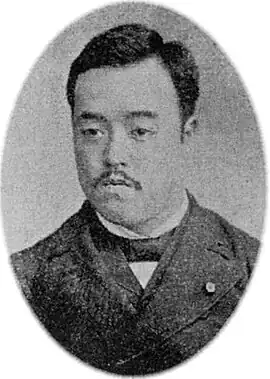| Toyotsu Domain (1870–1871)豊津藩 Kawara Domain (1867–1870)香春藩 Kokura Domain (1600–1867)小倉藩 | |
|---|---|
| Domain of Japan | |
| 1600–1871 | |
 Mon of the Ogasawara clan
| |
| Capital | Kokura Castle (1600–1867) Kawara jin'ya (1867–70) Toyotsu jin'ya (1870–71) |
| • Type | Daimyō |
| Historical era | Edo period Meiji period |
• Established | 1600 |
• Disestablished | 1871 |
| Today part of | Fukuoka Prefecture |


Kokura Domain (小倉藩, Kokura-han), also known as "Kawara-han" (香春藩) or then "Toyotsu-han" (豊津藩), was a Japanese domain of the Edo period. It was associated with Buzen Province in modern-day Fukuoka Prefecture on the island of Kyushu.
In the han system, Kokura was a political and economic abstraction based on periodic cadastral surveys and projected agricultural yields.[1] In other words, the domain was defined in terms of kokudaka, not land area.[2] This was different from the feudalism of the West.
History
In 1587, Motane Takahashi, the adopted heir of Kansei Takahashi, surrendered Kokura Castle to the invasion of Toyotomi's army. Mori Katsunobu, a vassal of Toyotomi Hideyoshi, was given 60,000 koku (one theory says 100,000 koku) of Buzen Kokura and entered Kokura Castle. Furthermore, his son Katsunaga was also given 10,000 koku (also known as 40,000 koku) in Buzen Province, and at this time, at Hideyoshi's arrangement, he changed his original surname Mori to the surname of the Mori clan, the Nawab of the Chugoku region. Mori Katsunobu and his son Katsunaga sided with the Western army at the Battle of Sekigahara and were forced to surrender. In 1600, Hosokawa Tadaoki fought as a member of the eastern army at the Battle of Sekigahara, and his castle, Tanabe Castle in Tango Province, stubbornly resisted the western army until his father, Hosokawa Yusai, made peace by imperial order (Battle of Tanabe Castle). ). As a result of his efforts, after the war, the Hosokawa family's wealth increased significantly from 180,000 koku in Tango Tanabe and Bungo Kitsuki to 399,000 koku in Buzen Province, Kunisaki District, and Hayami District in Bungo Province, and established the Kokura Domain. Initially, they entered Nakatsu Castle, but soon they began construction of a castle town and castle town on the site of the Mori clan's former Kokura Castle, and in 1602, they established the domain office at Kokura Castle. Moved. It was during this era of the Hosokawa clan that the duel between Musashi Miyomoto and Kojiro Sasaki took place on Ganryu Island, which was then part of the Kokura domain. In 1620, Tadaoki retired and his third son Tadatoshi became the second lord of the Kokura domain. Later, in 1632, Tadatoshi's fief was increased to 540,000 koku and transferred to the Kumamoto domain due to Kato Tadahiro's reform. In the same year, Tadatoshi's brother-in-law Ogasawara Tadazane from the Akashi domain in Harima Province joined the clan and took over 150,000 koku of land in northern Buzen as Kokura Castle. At that time, Tadazane's nephew Nagatsugu entered Buzen Nakatsu Castle, a branch castle, with 80,000 koku, forming the Nakatsu domain, and Tadazane's younger brother Tadatomo entered Bungo Kitsuki Castle with 40,000 koku, forming the Kitsuki domain. .
Since Tadazane's mother was the daughter of Matsudaira Nobuyasu and the great-great-granddaughter of Tokugawa Ieyasu , the Ogura-Ogasawara clan, as the leading feudal lord of the Sengoku region, held the gateway to Kyushu, and played the role of Kyushu Tandai, monitoring the Tozama daimyos. However, this was also the cause of the fall of Kokura Castle at the end of the Edo period. Musashi Miyamoto's heir, Iori Umoto, supported Tadazane by becoming the chief retainer of the Kokura clan with a wealth of 4,000 koku due to his military exploits during the Shimabara Rebellion, in which both his father and his father went to war, and the Miyamoto family subsequently inherited this position from generation to generation. When the second generation, Tadao, inherited the lordship of the domain in 1667, he divided 10,000 koku of the Kokura Nitta domain (Senzuka domain) into his younger brother Masakata.
In 1730, the second son of Tadaki, the third generation, was adopted by Ogasawara Nagaoki, the first lord of the Banshu Anshi domain, who had no heir, and succeeded him, and later became the Kokura domain and the Kokura Nitta domain. ・The three Ogasawara families of the Anshi clan deepened their relationship by marriage through the adoption of successors, and not only the Ogura Nitta clan but also the Anshi clan, which was originally the direct line of the Ogasawara clan, came to be positioned as a branch of the Ogasawara clan. It became a thing.
In 1758, the fourth generation, Tadaso, established Shieisai, a literary and military training ground for retainers of the domain, within Kokura Castle. This later became the domain school ``Shieikan.
In 1777, Inukai Tomohiro became chief retainer and reformed the domain's finances. Thanks to Inuma's efforts, his finances improved around 1798, and he was able to save 8,000 kan of silver, but due to a plot by opponents, he was overthrown in 1803, and was declared innocent. He was imprisoned for this crime and died a violent death there. After that, factional conflicts among senior vassals continued within the domain.
In 1811, during the era of the 6th feudal lord, Ogasawara Tadatatsu, the Goie Riot, also known as the Cultural Incident or the Black and White Riot, broke out.
In 1820, the district governor, Sadanori Sugiu, began industrial promotion measures, including river improvements on the Imagawa River, road improvements in various areas, and the construction of Ujima Port.
Village unrest also occurred during the Bunsei era. In 1854, at the end of the Edo period, reforms of the domain administration began under the chief retainer Shizuma Shimamura and the gun chief Shiro Kono. The collection and sale of major products such as agricultural products, coal, and pottery were managed by the domain organization, and while cultivating producers, they developed sales channels, and inspected the village management of the headman class to thoroughly clean up discipline.
In 1863, in order to strengthen the sea defenses, gun batteries such as Daiba Kuzuha, Daiba Higashihama, and Daiba Nishihama were constructed along the Kanmon Strait coast, and the recruitment and training of agricultural soldiers to serve as auxiliary troops also began. In this year, the Choshu clan on the opposite coast shelled foreign ships passing through the Kanmon Strait, leading to the Shimonoseki War, but the Shogunate ordered a unilateral preemptive attack on foreign ships that were not taking hostilities. However, the Kokura domain did not engage in any combat operations, although it did deploy them. Around this time, conflicts continued between the Choshu clan and the Choshu clan, with the Choshu clan unilaterally sending troops to occupy areas such as Tanoura, which was part of the Kokura clan's territory facing the Kanmon Straits, and attempting to build artillery batteries. After consultation with the Choshu clan, they tried to avoid an armed conflict with the Choshu domain and reach a negotiated solution. Relations with the Choshu clan were temporarily in a lull as the power of the Choshu clan weakened after the political change of August 18, and the occupied areas were returned. The Kokura domain continued to strive to strengthen its defenses, and in 1865, it purchased the steamship Hiryumaru. On July 14, 1871, The Kokura Domain became Toyotsu Prefecture due to the abolition of feudal domains and establishment of prefectures, and then was incorporated into Fukuoka Prefecture via Kokura Prefecture.
In 1869, the Ogasawara family was ranked as peerage, and in 1884, they were made earls.
In 1876, the Toyotsu samurai clan was forced to revolt by the Akizuki party, which had raised troops in the Akizuki Rebellion, but they took the policy of not joining the mob and the Kokura group led by Nogi Maresuke . Together with Chindai, he defeated the Akizuki Party.
List of daimyo
The hereditary daimyōs were head of the clan and head of the domain.
# Name Tenure Courtesy title Court Rank kokudaka  Hosokawa clan, 1600 - 1632 (Tozama daimyo)
Hosokawa clan, 1600 - 1632 (Tozama daimyo)1 Tadaoki (細川忠興) 1602 - 1620 Etchu no kami (絵t中 の 髪) Junior 5th Rank, Lower Grade (従五位下) 399,000 koku 2 Tadatoshi(細川 忠利) 1620 - 1632 Etchu no kami (絵t中 の 髪) Junior 5th Rank, Lower Grade (従五位下) 399,000 koku  Ogasawara clan, 1632 - 1871(Fudai daimyo)
Ogasawara clan, 1632 - 1871(Fudai daimyo)1 Tadazane (小笠原 忠真) 1632 - 1667 Sakon Shokan (左近 所管) Junior 5th Rank, Lower Grade (従五位下) 150,000 koku 2 Osagawara Tadao (小笠原忠雄) 1667 - 1725 Sakon Shokan (左近 所管) Junior 5th Rank, Lower Grade (従五位下) 150,000 koku 3 Osagawara Tadataka (小笠原 忠敬) 1725 - 1752 Totomi no kami (と富 の 髪) Junior 5th Rank, Lower Grade (従五位下) 150,000 koku 4 Osagawara Tadamoto (小笠原 ただ本) 1752 - 1790 Sakyo no Taifu (佐居 の 大夫) Junior 5th Rank, Lower Grade (従五位下) 150,000 koku 5 Osagawara Tadafusa (小笠原 タダフサ) 1791 - 1804 Iyo no kami (伊予 の 髪) Junior 5th Rank, Lower Grade (従五位下) 150,000 koku 6 Osagawara Tadamitsu (小笠原 忠光) 1804 - 1843 Daizen Daifu (第前 大斧=) Junior 5th Rank, Lower Grade (従五位下) 150,000 koku 7 Osagawara Tadataka (おさがわら ただたか) 1843 - 1856 Iyo no kami (伊予 の 髪) Junior 5th Rank, Lower Grade (従五位下) 150,000 koku 8 Osagawara Tadaakira (おさがわら ただあきら) 1856 - 1860 Iyo no kami (伊予 の 髪) Junior 5th Rank, Lower Grade (従五位下) 150,000 koku 9 Osagawara Tadohiro (おさがわら たどひろ) 1860 - 1865 Hyōbu Shosuke (ヒョ部 書すけ) Junior 5th Rank, Lower Grade (従五位下) 150,000 koku 10 Tadanobu(おさがわら ただのぶ 1865 - 1871 Sakon Shokan (左近 所管) Junior 4th Rank, Lower Grade (従五位下) 150,000 koku
See also
References

- ↑ Mass, Jeffrey P. and William B. Hauser. (1987). The Bakufu in Japanese History, p. 150.
- ↑ Elison, George and Bardwell L. Smith (1987). Warlords, Artists, & Commoners: Japan in the Sixteenth Century, p. 18.
External links
- (in Japanese) Kokura on "Edo 300 HTML" Archived 2012-01-14 at the Wayback Machine (9 Oct. 2007)